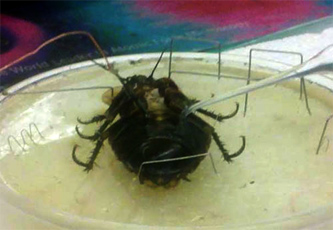 By David Ponce
By David Ponce
Remember how in the movie The Matrix, humans were used as energy sources by the machines? I personally thought the idea was inefficient; why not make batteries or something? But still, it appears that we are now the machines and have been able to rig a poor cockroach up with electrodes and squeeze out some measurable amount of electricity. “Maximum power density reached nearly 100 microwatts per square centimeter at 0.2 volts. Maximum current density was about 450 microamps per square centimeter.” It’s the chemical within the roach that power this particular reaction. And if you want the gritty details of how it was done, just hit the jump for a fuller description and links.
The key to converting the chemical energy is using enzymes in series at the anode.
The first enzyme breaks the sugar, trehalose, which a cockroach constantly produces from its food, into two simpler sugars, called monosaccharides. The second enzyme oxidizes the monosaccharides, releasing electrons.
The current flows as electrons are drawn to the cathode, where oxygen from air takes up the electrons and is reduced to water.
After testing the system using trehalose solutions, prototype electrodes were inserted in a blood sinus in the abdomen of a female cockroach, away from critical internal organs.
“Insects have an open circulatory system so the blood is not under much pressure,” Ritzmann explained. “So, unlike say a vertebrate, where if you pushed a probe into a vein or worse an artery (which is very high pressure) blood does not come out at any pressure. So, basically, this is really pretty benign. In fact, it is not unusual for the insect to right itself and walk or run away afterward.”
The researchers found the cockroaches suffered no long-term damage, which bodes well for long-term use.
To determine the output of the fuel cell, the group used an instrument called a potentiostat. Maximum power density reached nearly 100 microwatts per square centimeter at 0.2 volts. Maximum current density was about 450 microamps per square centimeter.
The study was five years in the making. Progress stalled for nearly a year due to difficulties with trehalase – the first enzyme used in the series.
Lee suggested they have the trehalase gene chemically synthesized to generate an expression plasmid, which is a DNA molecule separate from chromosomal DNA, to allow the production of large quantities of purified enzyme from Escherichia coli. “Michelle then began collecting enzyme that proved to have much higher specific activities than those obtained from commercial sources,” Lee said. “The new enzyme led to success.”
Case Western Reserve University ] VIA [ MedGadget ]





Ok, move aside “Mr. Fusion” and the “EverReady Bunny”, here comes “The EverReady Cockroach”! and they keep coming and coming and coming…
The only problem will come when NeoRoach is able to see the matrix and comes for us all!
All we need to do is network all the cockroaches in the world and we will be energy independent. Energizer Cockroach…..